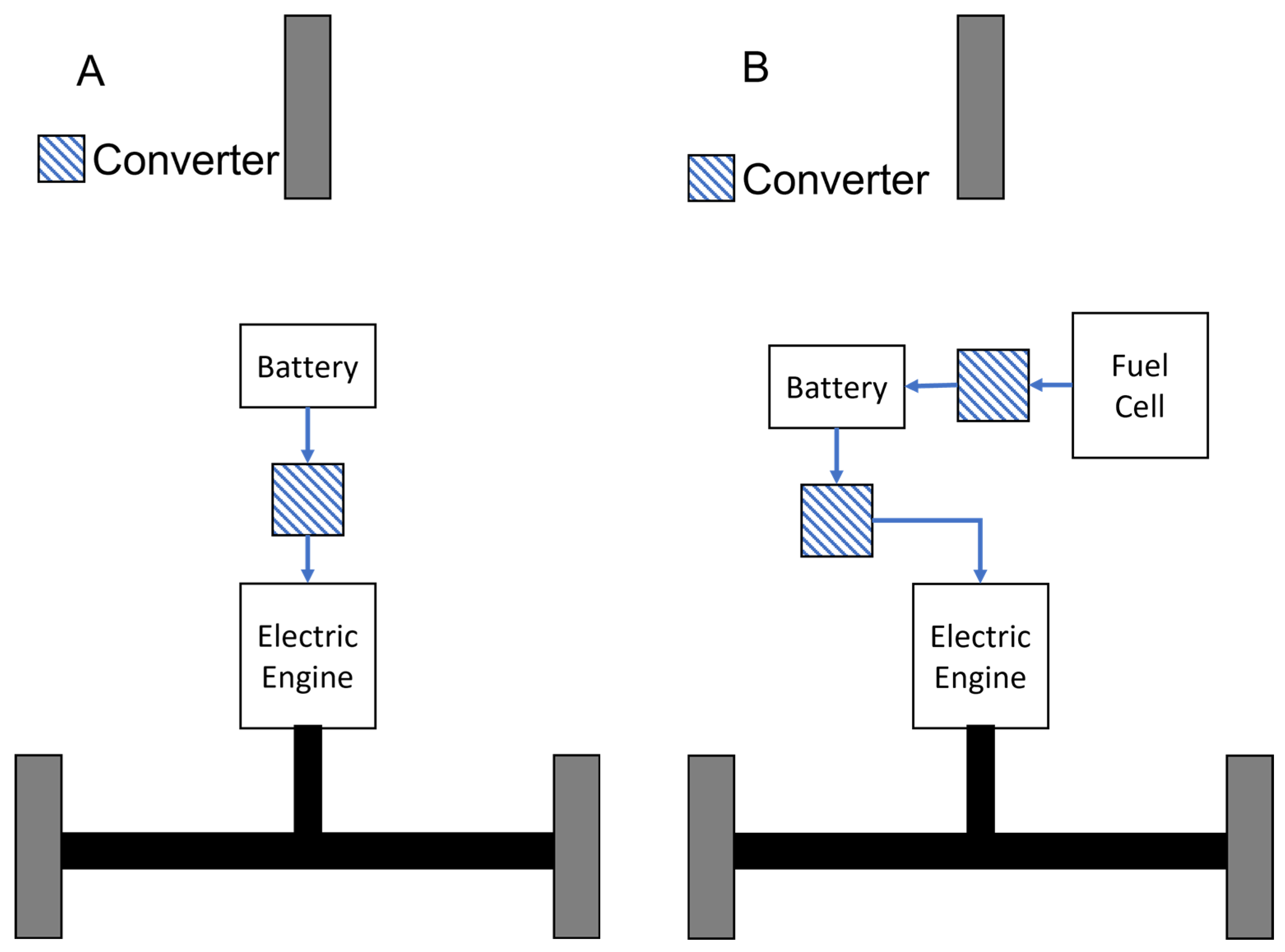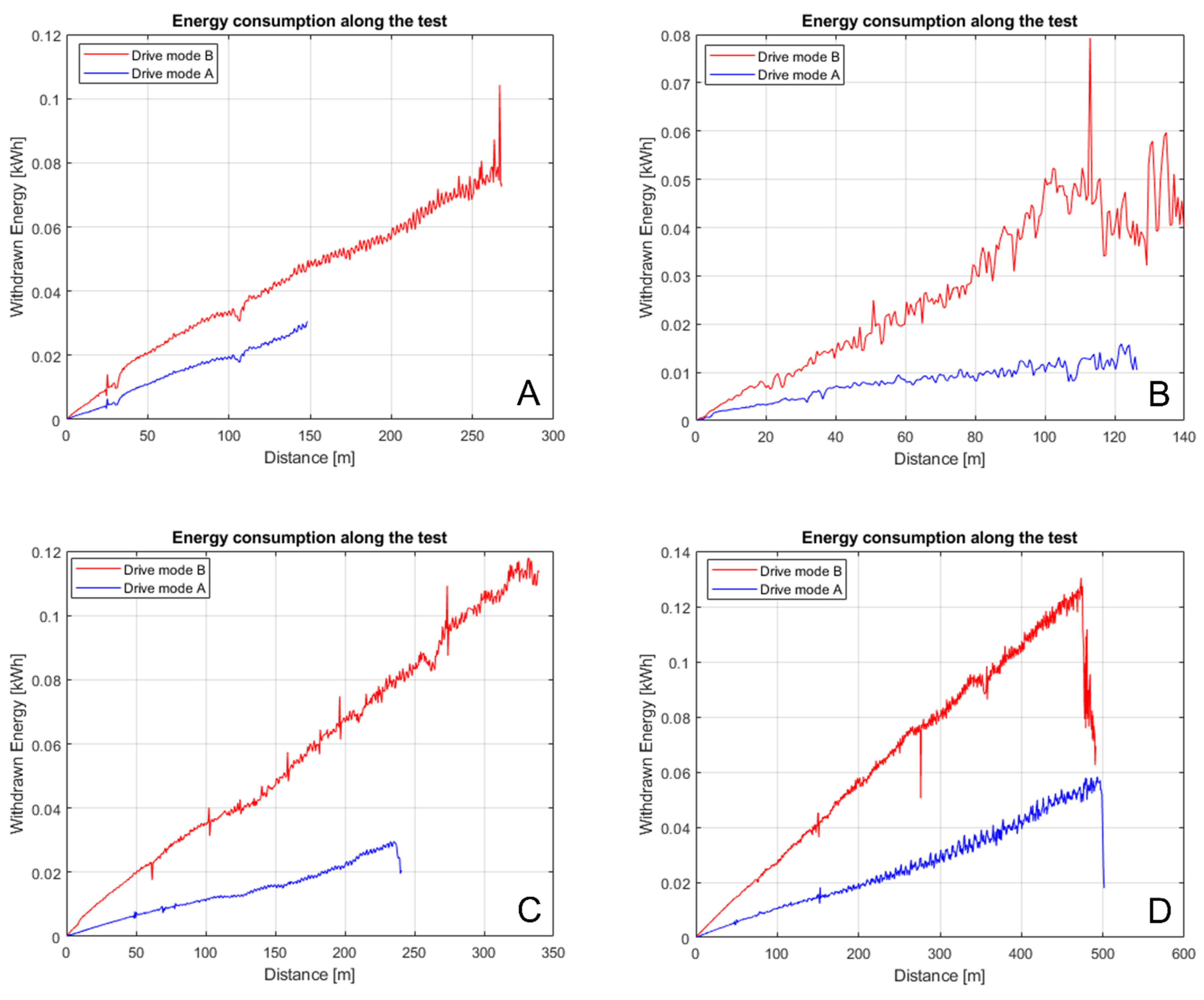Evaluation of a Hydrogen Powered Scooter Toy Prototype
Abstract
1. Introduction
2. Materials and Methods
2.1. Vehicle Design
2.1.1. Design of the Chassis and Steering
2.1.2. Design of the Power Transmission System
- F is the force needed to move the vehicle in N.
- D is the diameter of the wheels in m (0.084 m).
2.1.3. Design of the Control System
2.2. Test Procedure
- FL is the drag resistance force.
- FR is the traction force.
- ρair is equal to 0.8878 kg/m3 and corresponds to the density of the air at an altitude of 2640 m (considering that tests were performed in Bogotá, Colombia).
- CW is the drag coefficient for electric scooters. This factor is equal to 0.7 according to literature.
- A is the transversal section area in m2. It is equal to 0.0105 m2.
- V is the speed of the vehicle in m/s.
- CR is the Rolling resistance coefficient. This value depends on the speed and is calculated using Equation (4) [25]:
- g corresponds to the gravity acceleration.
- m corresponds to the weight of the vehicle.
- P is Power.
- η is the efficiency due to the motor and the gearbox.
- t is time up to discharge.
2.3. Experimental Design
2.4. Non-Dimensional Comparison Factor
- R is the maximum distance reached in the test in km.
- E is the specific withdrawn energy (Rolling resistance energy + Drag resistance energy + Inertia force energy) on each test in Wh/km × kg.
- SE is the specific energy of the battery and is obtained by the values of voltage and amperes of the battery (30.34 Wh). For the case with the hydrogen cell, the power value of the cell (60.34 Wh) is added. This variable is in Wh/kg.
3. Results
4. Conclusions
Author Contributions
Funding
Data Availability Statement
Conflicts of Interest
References
- Saxena, P.; Srivastava, A. Air Pollution and Total Environmental Health; Springer: Berlin/Heidelberg, Germany, 2020; Volume 20, ISBN 9789811534805. [Google Scholar]
- The World Bank Mobility. Available online: https://www.worldbank.org/en/results/2017/12/01/mobility (accessed on 16 November 2022).
- Bokaba, T.; Doorsamy, W.; Paul, B.S. A Comparative Study of Ensemble Models for Predicting Road Traffic Congestion. Appl. Sci. 2022, 12, 1337. [Google Scholar] [CrossRef]
- The World Bank Pollution. Available online: https://www.worldbank.org/en/topic/pollution (accessed on 16 November 2022).
- Amry, Y.; Elbouchikhi, E.; Le Gall, F.; Ghogho, M.; El Hani, S. Electric Vehicle Traction Drives and Charging Station Power Electronics: Current Status and Challenges. Energies 2022, 15, 6037. [Google Scholar] [CrossRef]
- Şengül, B.; Mostofi, H. Impacts of E-Micromobility on the Sustainability of Urban Transportation—A Systematic Review. Appl. Sci. 2021, 11, 5851. [Google Scholar] [CrossRef]
- Gössling, S. Integrating E-Scooters in Urban Transportation: Problems, Policies, and the Prospect of System Change. Transp. Res. Part D Transp. Environ. 2020, 79, 102230. [Google Scholar] [CrossRef]
- García-Olivares, A.; Solé, J.; Osychenko, O. Transportation in a 100% Renewable Energy System. Energy Convers. Manag. 2018, 158, 266–285. [Google Scholar] [CrossRef]
- Ramchandra Mouli, G.; Vanduijsen, P.; Velzeboer, T.; Nair, G.; Zhao, Y.; Jamodkar, A.; Isabella, O.; Silvester, S.; Bauer, P.; Zeman, M. Solar Powered E-Bike Charging Station with AC, DC and Contactless Charging. In Proceedings of the 20th European Conference on Power Electronics and Applications, EPE 2018 ECCE Europe, Riga, Latvia, 17–21 September 2018; pp. 1–10. [Google Scholar]
- Rohini, M.; Asha, S. A Review of Electric Vehicle Components. In Smart Technologies for Energy, Environment and Sustainable Development; Springer: Singapore, 2022; pp. 531–558. [Google Scholar]
- Moreau, H.; de Jamblinne de Meux, L.; Zeller, V.; D’Ans, P.; Ruwet, C.; Achten, W.M.J. Dockless E-Scooter: A Green Solution for Mobility? Comparative Case Study between Dockless e-Scooters, Displaced Transport, and Personal e-Scooters. Sustainability 2020, 12, 1803. [Google Scholar] [CrossRef]
- Karkera, G.; Reddy, M.A.; Fichtner, M. Recent Developments and Future Perspectives of Anionic Batteries. J. Power Sources 2021, 481, 228877. [Google Scholar] [CrossRef]
- Apostolou, D.; Casero, P.; Gil, V.; Xydis, G. Integration of a Light Mobility Urban Scale Hydrogen Refuelling Station for Cycling Purposes in the Transportation Market. Int. J. Hydrogen Energy 2021, 46, 5756–5762. [Google Scholar] [CrossRef]
- Dwivedi, S. Solid Oxide Fuel Cell: Materials for Anode, Cathode and Electrolyte. Int. J. Hydrogen Energy 2020, 45, 23988–24013. [Google Scholar] [CrossRef]
- Yang, F.; Wang, T.; Deng, X.; Dang, J.; Huang, Z.; Hu, S.; Li, Y.; Ouyang, M. Review on Hydrogen Safety Issues: Incident Statistics, Hydrogen Diffusion, and Detonation Process. Int. J. Hydrogen Energy 2021, 46, 31467–31488. [Google Scholar] [CrossRef]
- Samsun, R.C.; Rex, M.; Antoni, L.; Stolten, D. Deployment of Fuel Cell Vehicles and Hydrogen Refueling Station Infrastructure: A Global Overview and Perspectives. Energies 2022, 15, 4975. [Google Scholar] [CrossRef]
- Choi, Y.; Lee, J. Estimation of Liquid Hydrogen Fuels in Aviation. Aerospace 2022, 9, 564. [Google Scholar] [CrossRef]
- Haseli, Y.; Naterer, G.F.; Dincer, I. Comparative Assessment of Greenhouse Gas Mitigation of Hydrogen Passenger Trains. Int. J. Hydrogen Energy 2008, 33, 1788–1796. [Google Scholar] [CrossRef]
- Tolj, I.; Lototskyy, M.V.; Davids, M.W.; Pasupathi, S.; Swart, G.; Pollet, B.G. Fuel Cell-Battery Hybrid Powered Light Electric Vehicle (Golf Cart): Influence of Fuel Cell on the Driving Performance. Int. J. Hydrogen Energy 2013, 38, 10630–10639. [Google Scholar] [CrossRef]
- Cunanan, C.; Tran, M.K.; Lee, Y.; Kwok, S.; Leung, V.; Fowler, M. A Review of Heavy-Duty Vehicle Powertrain Technologies: Diesel Engine Vehicles, Battery Electric Vehicles, and Hydrogen Fuel Cell Electric Vehicles. Clean Technol. 2021, 3, 474–489. [Google Scholar] [CrossRef]
- Katz, E.; Bollella, P. Fuel Cells and Biofuel Cells: From Past to Perspectives. Isr. J. Chem. 2021, 61, 68–84. [Google Scholar] [CrossRef]
- Thomas, C.E. Fuel Cell and Battery Electric Vehicles Compared. Int. J. Hydrogen Energy 2009, 34, 6005–6020. [Google Scholar] [CrossRef]
- Manoharan, Y.; Hosseini, S.E.; Butler, B.; Alzhahrani, H.; Senior, B.T.F.; Ashuri, T.; Krohn, J. Hydrogen Fuel Cell Vehicles; Current Status and Future Prospect. Appl. Sci. 2019, 9, 2296. [Google Scholar] [CrossRef]
- Educational, H. H-Cell 2.0 User Manual; Horizon Eductional: Los Angeles, CA, USA, 2018; pp. 1–44. [Google Scholar]
- Mitschke, M.; Wallentowitz, H. Fahrwiderstände, Leistungsbedarf BT. In Dynamik der Kraftfahrzeuge; Mitschke, M., Wallentowitz, H., Eds.; Springer: Berlin/Heidelberg, Germany, 2004; pp. 67–79. ISBN 978-3-662-06802-1. [Google Scholar]
- Office of Technology Assessment; United States Environmental Protection Agency. Method for Evaluating Vehicle Performance. In Advanced Automotive Technology: Visions of a Super-Efficient Family Car; United States. Congress. Office of Technology Assessment: Washington, DC, USA, 1995; p. 26. [Google Scholar]
- Envyride Pulse Performance Safe Start Review—3-Wheel Toddler Electric ScooterPulse Performance Safe Start Review—3-Wheel Toddler Electric Scooter. Available online: https://envyride.com/pulse-performance-safe-start/ (accessed on 22 May 2022).
- Wu, D.; Ren, J.; Davies, H.; Shang, J.; Haas, O. Intelligent Hydrogen Fuel Cell Range Extender for Battery Electric Vehicles. World Electr. Veh. J. 2019, 10, 29. [Google Scholar] [CrossRef]
- Propfe, B.; Kreyenberg, D.; Wind, J.; Schmid, S. Market Penetration Analysis of Electric Vehicles in the German Passenger Car Market towards 2030. Int. J. Hydrogen Energy 2013, 38, 5201–5208. [Google Scholar] [CrossRef]







| Element | Characteristic | Value |
|---|---|---|
| Hydrogen Cartridge (H2) | Size | Ø22 × 88 mm |
| Capacity | 10 L of H2 (3 MPa–35 °C) | |
| H2 Purity | 99.995% | |
| Weight | ±105 g (charged) | |
| Charging Pressure | 3 MPa | |
| Work Temperature | 0–55 °C | |
| Hydrogen Cell | Type | PEM |
| Power | 30 W | |
| Max. Performance | 8.4 V @ 3.6 A | |
| Working Voltage | 6 V | |
| Reactants | Hydrogen and Air | |
| Max. Temperature | 55 °C | |
| Cooling | Air (Fan) | |
| Weight | 370 g | |
| H2 Flow | 0.42 L/min | |
| Hydrogen Pressure discharge | 45–55 kPa |
| Test | Nominal Speed (m/s) | Weight (kg) | Drive Mode |
|---|---|---|---|
| 1 | 0.0756 | 4.4 | A (Battery only) |
| 2 | 0.0756 | 5.0 | A (Battery only) |
| 3 | 0.0989 | 4.4 | A (Battery only) |
| 4 | 0.0989 | 5.0 | A (Battery only) |
| 5 | 0.0756 | 4.4 | B (Battery and hydrogen cell) |
| 6 | 0.0756 | 5.0 | B (Battery and hydrogen cell) |
| 7 | 0.0989 | 4.4 | B (Battery and hydrogen cell) |
| 8 | 0.0989 | 5.0 | B (Battery and hydrogen cell) |
| Test | 1 | 2 | 3 | 4 | 5 | |||
|---|---|---|---|---|---|---|---|---|
| Drive Mode | A | A | A | A | B | |||
| Average Speed [m/s] | 0.0585 (±0.00176) | 0.0698 (±0.00077) | 0.0846 (±0.00021) | 0.1156 (±0.000212) | 0.0756 (±0.00212) | |||
| Maximum Distance [m] | 148.18 (±3.54) | 126.38 (±3.96) | 240.45 (±3.95) | 490.98 (±4.277) | 267.85 (±3.55) | 139.8 (±3.16) | 339.46 (±3.97) | 501.6 (±0.0494) |
| Distance While Operating the Cell [m] | - | - | - | - | 154.34 (±4.74) | 62.63 (±3.16) | 177.82 (±3.95) | 347.82 (±3.95) |
| Total Time [h] | 0.76 (±0.0282) | 0.5391 (±0.0258) | 0.84 (±0.0141) | 1.23 (±0.0070) | 1.02 (±0.0042) | 0.634 (±0.0184) | 0.91 (±0.014) | 1.41 (±0.0183) |
| Withdrawn Energy [kWh] | 0.036 (±0.00141) | 0.0195 (±0.00346) | 0.037 (±0.0094) | 0.0584 (±0.0025) | 0.1073 (±0.00127) | 0.0548 (±0.0012) | 0.1330 (±0.015) | 0.1548 (±0.0070) |
| Fuel Efficiency (Hydrogen) [m/kg] | - | - | - | - | 3169.2 (±97.425) | 1286.04 (±0.158) | 3651.33 (±0.205) | 7142.1 (±81.168) |
| Combined Fuel Efficiency [kWh/m] | 0.000247 (±4.94 × 10−06) | 0.000155 (±2.43 × 10−05) | 0.000154 (±4.24 × 10−05) | 0.000116 (±1.55 × 10−05) | 0.000321 (±5.58 × 10−05) | 0.000392 (±2.12 × 10−07) | 0.000392 (±7.07 × 10−08) | 0.000315 (±1.41 × 10−06) |
| Non-Dimensional Comparison Factor RE/SE | 0.46 | 0.29 | 1.2 | 1.9 | 1.77 | 0.91 | 2.0 | 2.4 |
| Test | 1 | 2 | 3 | 4 | 5 | 6 | 7 | 8 |
| Drive Mode | A | A | A | A | B | B | B | B |
| Source | Charging Times | Average Range | Energy Consumption |
|---|---|---|---|
| Lipo Battery | 18 h | 251.49 M | 6 W/H |
| Hydrogen Charger | 10 h | 185.65 M | 2.5 W/H |
| Hybrid Mode | 18 h | 312.17 M | 8.5 W/H |
Publisher’s Note: MDPI stays neutral with regard to jurisdictional claims in published maps and institutional affiliations. |
© 2022 by the authors. Licensee MDPI, Basel, Switzerland. This article is an open access article distributed under the terms and conditions of the Creative Commons Attribution (CC BY) license (https://creativecommons.org/licenses/by/4.0/).
Share and Cite
Salazar, S.; Malagón, D.; Forero-García, E.; Torres, M.J.; Velasco Peña, M.A. Evaluation of a Hydrogen Powered Scooter Toy Prototype. Machines 2022, 10, 1134. https://doi.org/10.3390/machines10121134
Salazar S, Malagón D, Forero-García E, Torres MJ, Velasco Peña MA. Evaluation of a Hydrogen Powered Scooter Toy Prototype. Machines. 2022; 10(12):1134. https://doi.org/10.3390/machines10121134
Chicago/Turabian StyleSalazar, Santiago, Dionisio Malagón, Edwin Forero-García, María Josefina Torres, and Marco Antonio Velasco Peña. 2022. "Evaluation of a Hydrogen Powered Scooter Toy Prototype" Machines 10, no. 12: 1134. https://doi.org/10.3390/machines10121134
APA StyleSalazar, S., Malagón, D., Forero-García, E., Torres, M. J., & Velasco Peña, M. A. (2022). Evaluation of a Hydrogen Powered Scooter Toy Prototype. Machines, 10(12), 1134. https://doi.org/10.3390/machines10121134






